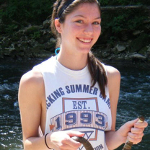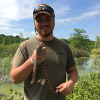Research Lab: Undergraduate Students

|

|

|

|

|
Are you interested in undergraduate research in behavioral ecology?
A small group of undergraduates conduct research in my laboratory each year. To be accepted into the lab, you need the following:
How do you become involved?
Make an appointment to talk with me. Be prepared to tell me why you are interested in research in my lab, describe your background, and convince me that you have the required time and passion that are required (above).
Undergraduate research projects from the Behavioral Ecology Lab
Research Topic |
Conference Presentations |
Journal Articles |
||
|---|---|---|---|---|
|
Derek Baker |
He is still deciding |

|
||
|
Sarah White |
The effects of habitat on antipredator responses in a conflicting odor landscape |
URD 2019
|

|
|
|
Jami Baker |
Response of Southern red-backed salamander to temporally-separated predators |

|
||
|
Kenzie Medley |
Dear Enemy behavior in Southern Red-backed Salamanders |
Undergraduate Research Day 2017 |

|
|
|
Katy Gardner |
Embryonic learning in Spotted Salamanders |
Missouri Herpetological Association
2016 |

|
|
|
Paige Farmer |
Influence of tail autotomy on mate choice in Plethodon |
Animal Behavior Society 2016 |

|
|
|
Kendell Loyd |
Learning in Plethodon |

|
||
|
Tom Radomski |
Cannibalism in larval Ambystoma |

|
||
|
Eric Green |
Cannibalism in larval Ambystoma |

|
||
|
Dana Green |
Cannibalism in larval Ambystoma |

|
||
|
Whitney Heuring |
Aggression in larval Ambystoma |
Animal Behavior Society |
Behavioral Processes 108:173-176 |

|
|
Courtney Heuring |
Aggression in larval Ambystoma |
Missouri Herpetological Association |

|
|
|
Michael Lampe |
Detection of earthworm alarm cues by Plethodon |
Missouri Herpetological Association |
Ethology, Ecology, & Evolution |

|
|
Megan Smith |
Dear enemy recognition in Plethodon |
Missouri Herpetological Association |
||
|
Michael L. Moore |
Hatching of Ambystoma eggs following embryonic exposures |
|||
|
Erin Murray |
Antipredator behavior of Ambystoma following embryonic exposures |
|||
|
Valerie Jones |
Increased blood flow to gills in response to predator cues in Ambystoma |
Missouri Herpetological Association |

|
|
|
John Lisek |
Glochidia parasites and darter behavior |
Missouri Herpetological Association |
||
|
Eric Britzke |
Plethodon dorsalis aggression |
Frontiers in Zoology 1(1):76. DOI: 10.1186/s12983-014-0076-7 |
||
|
Kyle Shull |
Effects of stress on metabolism in Plethodon |
|||
|
Carly McGrane |
Salamander recognition of armadillos by Plethodon |
Behavioral Ecology and Sociobiology 66:811-817 |

|
|
|
Laura Sanders |
Learned habitat avoidance in Plethodon |
|||
|
Matthew Lewis |
Predator recognition by shiners: visual cues |
|||
|
Dave Schmidt |
Territoriality in in Plethodon |
The American Midland Naturalist 143:245-249 |
||
|
Johnny Shelley |
Habitat selection under predation risk in darters |
|||
|
Dan Rippetoe |
Alarm cues of Eurycea |
Southwestern Association of Naturalists |
||
|
Kelly Wells |
Antipredator behavior of larval ringed salamanders |
|||
|
Kevin Murray |
Predator recognition my larval ringed salamanders |
Animal Behavior Society |
Ethology 109:159-170 |
|
|
Amy Commens |
Alarm pheromones of darters |
Animal Behavior Society |
Journal of Fish Biology 55:1359-1362 |

|
|
Michael Anderson |
Diet of tropical salamanders |
Journal of Herpetology 33:601-607 |
||
|
Misty Summey |
Alarm pheromones of tropical tadpoles |
Herpetologica 54:402-408 |
||
|
Krista Deckard |
Aggression/chemical communication by Plethodon serratus |
Prairie State Ecology Conclave |
Southwest Naturalist 40:1-5 |
|
|
Shelley Grow |
Natural history of three species of tropical frogs |
Missouri Herpetological Association |
||
|
Jeff Johnson |
Aggression by long-eared sunfish |
|||
|
Rodney Morgan |
Larval newt skin histology |
|||
|
Frank Vincent |
Predator recognition by larval newts |
Animal Behavior Society |
Canadian Journal of Zoology 78:1646-1652 |
|
|
Cherie Gelowitz |
Population differences in response to predation risk |
Ecological and Evolutionary Ethology of Fishes |
Behaviour 127:105-118 |
